Summary: in this tutorial, you will learn how to use the Oracle ROLLUP extension to generate reports that contain subtotals and totals.
Getting started with Oracle ROLLUP
Consider the following orders and order_items tables in the sample database:
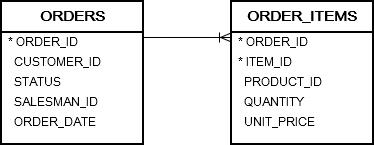
The following query returns the sales revenue by customers in the year of 2017. It calculates net values for the sales orders with the Shipped status and is in charge of a salesman.
SELECT
customer_id,
SUM(quantity * unit_price) amount
FROM
orders
INNER JOIN order_items USING (order_id)
WHERE
status = 'Shipped' AND
salesman_id IS NOT NULL AND
EXTRACT(YEAR FROM order_date) = 2017
GROUP BY
customer_id
ORDER BY
amount DESC;
Code language: SQL (Structured Query Language) (sql)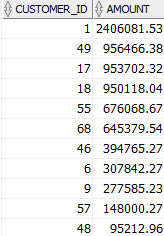
To get the sum of the values in the amount column, you may come up with the following subquery:
SELECT
SUM(amount)
FROM
(
SELECT
customer_id,
SUM(quantity * unit_price) amount
FROM
orders
INNER JOIN order_items USING (order_id)
WHERE
status = 'Shipped' AND
salesman_id IS NOT NULL AND
EXTRACT(YEAR FROM order_date) = 2017
GROUP BY
customer_id
);
Code language: SQL (Structured Query Language) (sql)
Oracle provides a better and faster way to calculate the grand total by using the ROLLUP as shown in the following query:
SELECT
customer_id,
SUM(quantity * unit_price) amount
FROM
orders
INNER JOIN order_items USING (order_id)
WHERE
status = 'Shipped' AND
salesman_id IS NOT NULL AND
EXTRACT(YEAR FROM order_date) = 2017
GROUP BY
ROLLUP(customer_id);
Code language: SQL (Structured Query Language) (sql)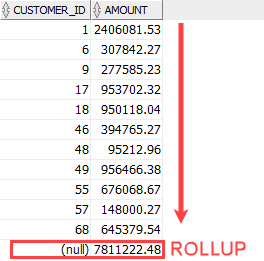
In this query, we used the ROLLUP expression to calculate the grand total of sales amounts of the selected orders.
As shown clearly from the output, the row with a NULL value in the customer_id column denotes the grand total row. The amount column of the grand total row showed the sum of all amounts in the output.
Oracle ROLLUP syntax
The ROLLUP is an extension of the GROUP BY clause. The ROLLUP calculates multiple levels of subtotals across a group of columns (or dimensions) along with the grand total.
The following illustrates the syntax of the ROLLUP :
SELECT
col1,
col2,
aggregate(col3)
FROM
table_name
GROUP BY
ROLLUP (col1, col2);
Code language: SQL (Structured Query Language) (sql)In the query syntax above, the ROLLUP creates subtotals that roll up from the most detailed level to a grand total, following a grouping column specified in the ROLLUP.
The ROLLUP works as follows:
- First, calculate the standard aggregate values in the
GROUP BYclause. - Then, progressively create higher-level subtotals of the grouping columns, which are
col2andcol1columns, from right to left. - Finally, calculate the grand total.
The ROLLUP clause generates the number of grouping sets which is the same as the number of grouping columns specified in the ROLLUP plus a grand total. In other words, if you have n columns listed in the ROLLUP, you will get n+ 1 level of subtotals with ROLLUP.
In the syntax above, the ROLLUP clause generates the following grouping sets:
- (col1, col2)
- (col2)
- (grand total)
The number of rows in the output is derived from the number of unique combinations of values in the grouping columns.
To reduce the number of subtotals, you can perform a partial roll-up as shown in the following syntax:
SELECT
col1,
col2,
aggregate(col3)
FROM
table_name
GROUP BY
col1,
ROLLUP (col2);
Code language: SQL (Structured Query Language) (sql)More Oracle ROLLUP examples
The following example use ROLLUP to return the sales values by salesman and customer:
SELECT
salesman_id,
customer_id,
SUM(quantity * unit_price) amount
FROM
orders
INNER JOIN order_items USING (order_id)
WHERE
status = 'Shipped' AND
salesman_id IS NOT NULL AND
EXTRACT(YEAR FROM order_date) = 2017
GROUP BY
ROLLUP(salesman_id,customer_id);
Code language: SQL (Structured Query Language) (sql)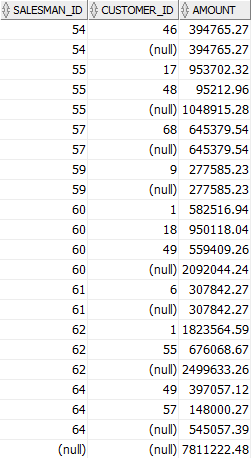
As you can see from the output, the query returned the following set of rows:
- The regular aggregation rows that would be returned by the
GROUP BYclause without using theROLLUPexpression. - The first level of subtotals aggregating across salesman for each combination of salesman and customer.
- The second-level subtotals aggregating across salesman and customer for each salesman.
- A grand total row.
The following query performs a partial rollup:
SELECT
salesman_id,
customer_id,
SUM(quantity * unit_price) amount
FROM
orders
INNER JOIN order_items USING (order_id)
WHERE
status = 'Shipped' AND
salesman_id IS NOT NULL AND
EXTRACT(YEAR FROM order_date) = 2017
GROUP BY
salesman_id,
ROLLUP(customer_id);
Code language: SQL (Structured Query Language) (sql)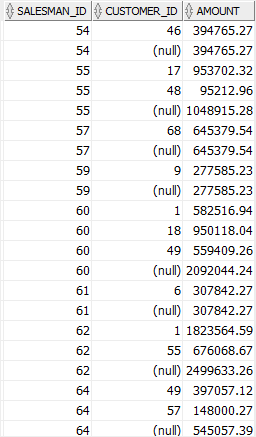
The query outputs regular aggregation rows that would be returned by the GROUP BY clause without using the ROLLUP and the subtotals aggregating across salesman for each combination of salesman and customer.
In this tutorial, you have learned how to use the Oracle ROLLUP to generate reports that contain subtotals and totals.